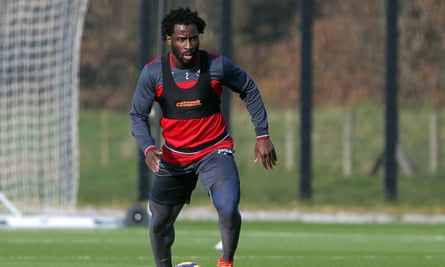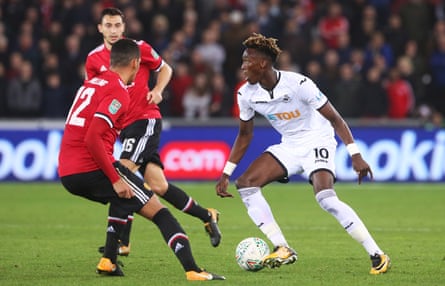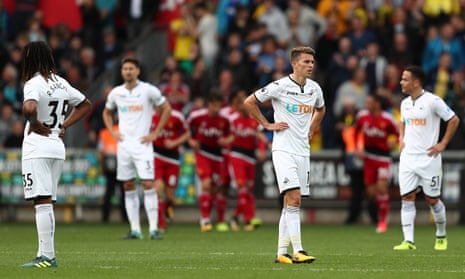It is rarely a good sign when players describe a game as “massive” and “must-win” at a time of the year when leaves are still falling from trees but that has been the sort of rhetoric doing the rounds at Swansea City before Brighton & Hove Albion’s visit on Saturday. Outside the bottom three only on goal difference after four defeats from their past five league matches, Swansea are veering back into the kind of territory they hoped they had left behind towards the end of last season.
Not only last season but the one before, which tells a story. Swansea, once seen as the Premier League’s model club, have badly lost their way. The Swansea Way – tiki-taka football, shrewd recruitment, savvy decision-making and inner belief that every game is winnable – disappeared years ago, replaced by pragmatism on the pitch, some scattergun thinking off it, winters of discontent and now the threat of a third successive relegation battle.
The latest scenario is one that everyone at Swansea was determined to avoid after accepting that a bullet had been dodged last season. Bottom of the table at the start of the year, Swansea had already sacked two managers before Paul Clement engineered a remarkable turnaround that saw 28 points gleaned in the second half of the season. A mixture of relief and elation swept through the club on the back of survival – as well as a warning. “Lessons need to be learned because we’ve seen that, if you keep flirting with it, eventually you go down,” said Leon Britton, the club captain, in an interview with the Guardian at the end of that chaotic campaign.
Almost six months later and Swansea are in danger of getting sucked into another dogfight, largely because of a poor summer transfer window in which the club lost Gylfi Sigurdsson and Fernando Llorente, their two most influential players, and finished with the lowest net spend in the Premier League. Or, to put it another way, Swansea were about £25m in profit come the start of September but ill-equipped on the pitch, so much so that three positions have already been identified as areas that must be strengthened when the window reopens.
The frustration for supporters is that history is repeating itself, given that only last January Swansea spent £16m on four signings – Tom Carroll, Jordan Ayew, Martin Olsson and Luciano Narsingh – to boost their survival prospects. Swansea will almost certainly need to do that and more this time around, with the absolute priority a creative attacking player to bring some craft and guile to a prosaic team.
Swansea have registered only 20 shots on target in 10 Premier League matches. To put that into context, since Opta started gathering this data in 2006, only three teams – Sunderland in 2012-13, Aston Villa in 2014-15 and Burnley in 2016-17 – have had fewer at this stage of a top-flight season.
Clement has faced some criticism from fans for an overly cautious approach, particularly away, where Swansea’s number of touches in the opposition penalty area in each of their five matches have been in single figures. The five points gathered on the road have provided a reward of sorts but little has gone right at home, where a glaring lack of imagination and invention in Swansea’s attacking play has contributed to four defeats.
Everyone at Swansea could, and should, have seen the creativity problem coming when they looked at the make-up of the squad. Across 794 top-flight appearances, predominantly in the Premier League, but also in La Liga, the Bundesliga, the Eredivisie and Portugal’s Primeira Liga, Swansea’s 22 outfield players registered only 40 assists between them in the previous two seasons. In short, what you see is what you get – Swansea’s eight broadly similar central midfielders created as many goals (13) in 332 appearances over two years as Sigurdsson managed on his own last season.

Transfer strategy is at the heart of the issue and serious questions have to be asked of all those involved in what Swansea describe as a collaborative approach to recruitment. It is a long list that includes Steve Kaplan and Jason Levien, the club’s American majority shareholders, Huw Jenkins, the chairman, David Leadbeater, the chief scout, Tim Henderson, the head of technical player recruitment, and Dan Altman, an analytics specialist, as well as Clement.
An internal review of what went on during the transfer window would certainly make for interesting reading because if the thinking at Swansea is joined up, then it also appears muddled. It is hard, for example, to come up with a logical reason for signing three central midfielders – Roque Mesa, Sam Clucas and Renato Sanches – when there were already five at the club. How could Swansea leave themselves in a position where they have to play a midfielder in defence because they have only one recognised left-back? Why was there no replacement for Sigurdsson, despite the fact that Swansea knew he was leaving for months? Who thought that Kyle Naughton was good enough to continue at right-back? And if Wilfried Bony was rejoining, would it not have made sense to sign him in July and give him half a dozen pre-season matches to get fit?
Some of the answers are easier to find than others and probably the best place to start is with the first deal of the summer and the one piece of good news for Swansea. Tammy Abraham, who joined on a season-long loan from Chelsea, has been an instant success, scoring four and creating one of Swansea’s seven league goals and deservedly earning a full England call up in the process.
Clement pushed strongly for that deal and the one other transfer that the head coach was absolutely central to was Sanches, who signed on a season-long loan from Bayern Munich. Sanches was seen as a coup for Swansea at the time and there was huge excitement around the club. Yet in retrospect and with the benefit of hindsight, the arrival of the Portugal international probably clouded the judgment of plenty of people, inside as well as outside the club, when it came to how successful Swansea’s transfer business had been. Sanches was never going to address the fundamental weakness in the No10 position and, to compound things, it has quickly become clear that his difficult first season at Bayern, where he ended up as something of a forgotten man, damaged him psychologically and left him short physically.
In between those two signings at either end of the window was the Sigurdsson saga, which arguably did more damage than anything else. Swansea did not make a signing in the 36 days between Sigurdsson refusing to board the plane to the United States for their pre-season tour and the moment when he was finally pictured in an Everton shirt, by which point there were only two weeks to go before the window closed.
Kaplan and Levien had initially hoped Sigurdsson could be talked into staying, but the Icelander made it clear that he wanted a new challenge. The Americans looked at the transfer fees being paid elsewhere and made a stand over their valuation. Talks were painfully slow – something that Kaplan and Levien put down to a dysfunctional approach to negotiations at the Everton end. That may well have been the case but an alternative view – and one shared by senior figures within Swansea – is that the club should have cut Sigurdsson loose long before, even it meant writing off a few million pounds. Kaplan and Levien claim that was not possible because Everton took an age to put a concrete offer on the table.
Either way, another argument would be that Swansea should have carried on with their business regardless, given that it always felt like a matter of when, not if, the Sigurdsson money would come through, and negotiating with other clubs over targets was always going to be harder with £40m burning a hole in their pocket. Kaplan and Levien were neither willing, nor able, to take that risk because as well as worrying about what would happen if Sigurdsson picked up a serious injury in training, the truth is that the money is not there to spend beyond what the club brings in. In that respect, some Swansea supporters will inevitably question just how big a difference last year’s change of ownership has made to the club’s ability to compete in the transfer market.

In terms of Sigurdsson’s replacement – and it was never going to be like-for-like – Clement identified Nacer Chadli at the beginning of the summer. He saw Chadli as someone who could play in a variety of attacking positions as well as right wing-back, and talks between West Brom and Swansea took place throughout the window. John Williams, Albion’s chairman, dropped the asking price from £28m to £25.5m on deadline day, perhaps hoping that Swansea would cave in, yet despite discussions going right to the wire, the clubs were never remotely close to reaching an agreement.
While the rights and wrongs of Swansea’s stance over Chadli are open to debate, it seems obvious that the club should have had alternatives on the table and been more creative in their transfer targets in that area. The sight of Pascal Gross running out in a Brighton shirt at the Liberty Stadium will hammer that point home. Gross was signed for £3m from relegated Inglostadt and for two seasons running in the Bundesliga the 26-year-old was top of the list for chances created. Ten games into his first Premier League campaign and Gross already has five assists and two goals to his name. Why on earth was he not on Swansea’s radar?
Instead the same old names seem to crop up again and again, including Bony, whose return to Swansea for £10m feels like a huge gamble. Bony has been struggling for fitness ever since arriving, which was always likely to be the case because he never featured in a single pre-season game for Manchester City and has not played 90 minutes at club level for 14 months. Other, younger striker options were on the table, including Vincent Aboubakar, who has scored 11 goals in 13 games for Porto this season, and Vincent Janssen, who rejected the chance to move to the Liberty Stadium on loan from Spurs but would have been available on a permanent deal.
Clucas arrived at Swansea from Hull, with Stephen Kingsley, Olsson’s understudy at left-back, moving in the opposite direction and leaving Clement without cover in that department. On the other side of the pitch Swansea were in the market for a right-back – PSV’s Santiago Arias and Barnsley’s Andy Yiadom both came under consideration – and it increasingly feels like an error of judgment to fail to sign one of them. Naughton, Swansea’s first-choice right-back, is playing without any pressure on him and has struggled badly. The days when full-back was a role that could be considered well down the list of priorities are long gone; Naughton has touched the ball 120 times more than any other Swansea player this season.
The net result of all that activity, or lack of it in some cases, is that Swansea spent about £40m (including loan fees) on Clucas, Mesa, Bony, Sanches and Abraham, and only one of them has had a positive impact at the club so far. Mesa is the most curious deal of the lot on the face of it, with many Swansea fans feeling that the Spaniard, who was signed from Las Palmas for £11m, has not been given a fair crack of the whip. Clement has talked about Mesa needing more time to adapt to get up to speed with the English game but his omission from the starting lineup has gone on long enough now to lead many to believe that he will be back in La Liga before long.
In fairness, recruitment at Premier League level is not easy by any stretch, especially in the market in which Swansea are operating, but that makes it all the more important that the club gets most signings right. Jenkins bridles at any criticism of the club’s transfer dealings over the past few seasons and actually believes he should be more involved rather than less. He will point to players such as André Ayew, Llorente and Alfie Mawson as evidence of their successes, yet there have also been plenty of expensive failures, such as Borja Bastón, Alberto Paloschi and Eder – and the worry for Swansea is that the list is about to get longer.
All the while supporter frustration is building – a legacy of what has gone on the last few seasons, not just this one. Patience has been stretched to the point where a misplaced pass is met with a thousand sighs, which feels a long way from the ‘Swansealona’ days that flashed up in a graphic on Match of the Day last Saturday, when Pep Guardiola’s side broke the record for completed Premier League passes against West Brom, nudging Swansea’s 2012 vintage down to third place in the process.
Against Brighton it will be all about three points rather than possession, although there is no suggestion that Clement’s position is under any threat. Swansea’s owners recognise the job that he did last season, when the club looked doomed under first Francesco Guidolin and then Bob Bradley, and talk about the head coach having plenty of credit. It would be stretching it to say that the same is true of Swansea’s bank balance, but whatever the club do have available to spend in January, they need to use it wisely, because Britton’s warning at the end of last season is starting to feel worryingly prescient.

Comments (…)
Sign in or create your Guardian account to join the discussion